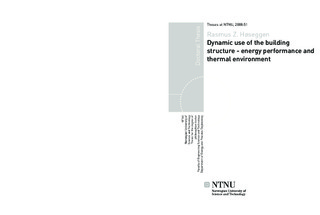| dc.contributor.author | Høseggen, Rasmus Z | nb_NO |
| dc.date.accessioned | 2014-12-19T11:43:39Z | |
| dc.date.available | 2014-12-19T11:43:39Z | |
| dc.date.created | 2008-03-25 | nb_NO |
| dc.date.issued | 2008 | nb_NO |
| dc.identifier | 123833 | nb_NO |
| dc.identifier.isbn | 978-82-471-6941-4 | nb_NO |
| dc.identifier.uri | http://hdl.handle.net/11250/233357 | |
| dc.description.abstract | The main objectives of this thesis have been to evaluate how, under which premises, and to what extent building thermal mass can contribute to reduce the net energy demand in office buildings. The thesis also assesses the potential thermal environmental benefits of utilizing thermal mass in office buildings, i.e. reduction of temperature peaks, reduction of temperature swings, and the reduction in the number of hours with excessive operative temperatures. This has been done by literature searches, and experimental and analytical assessments. This thesis mainly concerns office buildings in the Norwegian climate. However, the methods used and the results obtained from this work are transferable to other countries with similar climates and building codes.
Within the limitations of this thesis and based on the findings from all parts and papers this thesis comprises, it is shown that utilization of thermal mass in office buildings reduces the daytime peak temperature, reduces the diurnal temperature swing, decreases the number of hours with excessive temperatures, and increases the ability of a space to handle daytime heat loads. Exposed thermal mass also contributes to decrease the net cooling demand in buildings. However, thermal mass is found to have only a minor influence on the heating demand in office buildings.
The quantity of the achievements is dependent on the amount of exposed thermal mass, night ventilation strategy, and airflow rates. In addition, parameters such as set point temperatures, control ranges, occupancy patterns, daytime ventilation airflow rates, and prevailing convection regimes are influential for the achieved result. The importance of these parameters are quantified and discussed. | nb_NO |
| dc.description.abstract | Hovedmålene med denne avhandlingen har vært å evaluere hvordan, under hvilke forutsetninger og i hvilken utstrekning termisk masse kan bidra til å redusere netto energibehov i kontorbygninger. Avhandlingen vurderer også hvilke potensielle fordeler termisk masse har for det termiske inneklimaet, dvs. reduksjon av maksimumstemperatur, temperatursvingninger og antall timer med overtemperaturer. Disse undersøkelsene er gjort gjennom søk i litteraturen, feltstudier og analytiske metoder. Avhandlingen omfatter i hovedsak kontorbygninger under norske forhold, men metodene og resultatene er overførbare til andre land med sammenlignbare klimatiske forhold og byggeskikk.
Innenfor avgrensningene gjort i avhandlingen og basert funnene i de ulike delene og artiklene avhandlingen består av, er det vist at utnyttelse av termisk masse i kontorbygg bidrar til å redusere netto energibehov. Termisk masse reduserer også maksimumstemperaturen dagtid, demper temperaturvariasjonene over døgnet og reduserer antall timer med overtemperaturer. Utnyttelse av termisk masse bidrar også til at rom kan tåle en høyere intern varmelast enn lette rom uten at dette går ut over den termiske komforten. Termisk masse har imidlertid liten betydning for energibehovet for oppvarming i kontorbygg.
Gevinsten med å utnytte termisk masse avhenger av tilgjengeligheten av eksponerte tunge materialer, strategi for nattventilasjon og ventilasjonsluftmengder. I tillegg innvirker parametere som settpunkttemperaturer, dødbånd og kontrollintervaller for ventilasjonen og bruksmønster. Innvirkningen av disse parametrene er diskutert og kvantifisert. | nb_NO |
| dc.language | eng | nb_NO |
| dc.publisher | Fakultet for ingeniørvitenskap og teknologi | nb_NO |
| dc.relation.ispartofseries | Doktoravhandlinger ved NTNU, 1503-8181; 2008:51 | nb_NO |
| dc.subject | thermal mass | en_GB |
| dc.subject | energy demand | en_GB |
| dc.subject | thermal comfort | en_GB |
| dc.subject | termisk masse | en_GB |
| dc.subject | energibehov | en_GB |
| dc.subject | termisk komfort | en_GB |
| dc.title | Dynamic use of the building structure - energy performance and thermal environment | nb_NO |
| dc.type | Doctoral thesis | nb_NO |
| dc.contributor.department | Norges teknisk-naturvitenskapelige universitet, Fakultet for ingeniørvitenskap og teknologi, Institutt for energi- og prosessteknikk | nb_NO |
| dc.description.degree | PhD i energi- og prosessteknikk | nb_NO |
| dc.description.degree | PhD in Energy and Process Engineering | en_GB |
